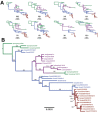Spread of Canine Influenza A(H3N2) Virus, United States
- PMID: 28858604
- PMCID: PMC5708240
- DOI: 10.3201/eid2312.170246
Spread of Canine Influenza A(H3N2) Virus, United States
Abstract
A canine influenza A(H3N2) virus emerged in the United States in February-March 2015, causing respiratory disease in dogs. The virus had previously been circulating among dogs in Asia, where it originated through the transfer of an avian-origin influenza virus around 2005 and continues to circulate. Sequence analysis suggests the US outbreak was initiated by a single introduction, in Chicago, of an H3N2 canine influenza virus circulating among dogs in South Korea in 2015. Despite local control measures, the virus has continued circulating among dogs in and around Chicago and has spread to several other areas of the country, particularly Georgia and North Carolina, although these secondary outbreaks appear to have ended within a few months. Some genetic variation has accumulated among the US viruses, with the appearance of regional-temporal lineages. The potential for interspecies transmission and zoonotic events involving this newly emerged influenza A virus is currently unknown.
Keywords: CIV; Chicago; H3N2; Illinois; South Korea; United States; canine influenza virus; dog influenza; influenza; influenza virus; outbreak; viruses; zoonoses.
Figures




References
-
- Yoon S-W, Webby RJ, Webster RG. Evolution and ecology of influenza A viruses. In: Compans RW, Oldstone MBA, editors. Influenza pathogenesis and control, volume I [cited 2017 Jan 25]. http://link.springer.com/chapter/10.1007/82_2014_396 - DOI
Publication types
MeSH terms
Grants and funding
LinkOut - more resources
Full Text Sources
Other Literature Sources

